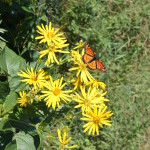 In this part of Wisconsin, we’re fortunate to be surrounded by many types of public land: county forests, ruggedly beautiful state parks, a huge national wildlife refuge, and more. But the public lands that I use most often are those strangely unnatural avenues for exploring the natural world: rails-to-trail bike paths.
In this part of Wisconsin, we’re fortunate to be surrounded by many types of public land: county forests, ruggedly beautiful state parks, a huge national wildlife refuge, and more. But the public lands that I use most often are those strangely unnatural avenues for exploring the natural world: rails-to-trail bike paths.
The phenomenon of converting abandoned rail beds to recreational paths has spread across the continent, but it started right here with the former Chicago and North Western Railroad line that became the Elroy-Sparta Trail in 1965.
Railroad builders, working mostly in the 1800s and early 1900s, found – or blasted, or banked up – routes that were as straight and level as possible. As a result, many of the trails provide a sort of cross-section of the landscape, slicing through farmlands, river bottoms, wood lots, and other types of habitat. Because the trail’s surface is level and relatively free of vegetation, it’s often possible to walk more quietly than in a field or forest. That sometimes makes it easier to catch a glimpse of secretive birds and even a number of mammals, from shrews and chipmunks to deer.
And despite their industrial history, rail-to-trail paths can be good places to find a surprising variety of native plants. In A Sand County Almanac, Aldo Leopold observed that rail corridors, unlike the surrounding landscape, had escaped the plow. Therefore, he wrote, “the prairie flora still splashes its calendar of colors, from pink shooting-star in May to blue aster in October.” Indeed Leopold, and many who came after him, turned to the railroad right-of-way as a reliable source of plant seeds for prairie restorations.

Look for native plants and pollinators along trails, like this cup plant and viceroy butterfly photographed in August.
The trails that I frequent are far from being pristine prairie remnants. Here, the soggy ground along the Baraboo River’s course required that the rail be laid atop an artificial berm – a berm that bisects several wetlands and in many places obstructs the natural water flow that once fed the river.
Still, the margins of the old right-of-way have been relatively undisturbed for decades, offering a bit of refuge to wildlife and wild plants. And the locomotive’s-eye view allows me to contemplate some of the ways that the land has been re-shaped and the rivers and wetlands altered in the pursuit of human ends. Ends like food production and transportation are obviously valuable to us. But there’s also value in being clear-eyed about the effects of our pursuits and in knowing what was previously here.
Sometimes, on the other hand, the breeze rustles through the autumn leaves, a red squirrel scolds me from a nearby tree, or a wooly bear creeps across my path…and I just want to think about what’s here today. Bike trails are good for that, too.
